This ChatGPT SEO guide is created to help individuals take advantage of the potential of ChatGPT for SEO. ChatGPT has rapidly gained popularity with over 1 million users registered in just 5 days. This guide provides an in-depth understanding of utilizing ChatGPT to improve your SEO and attain higher search engine rankings.
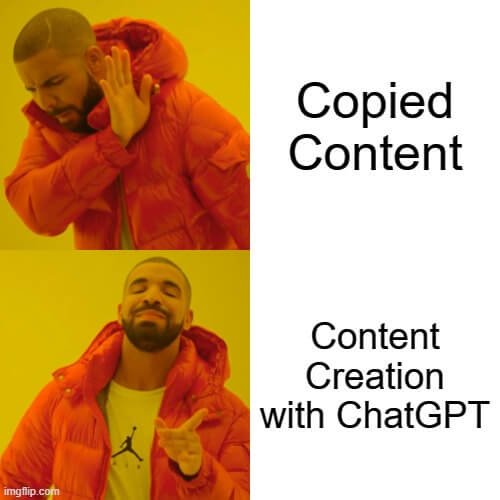
What is ChatGPT and its origins?
ChatGPT, or Chatterbot GPT-3, launched publicly in Nov 2022 is a new, powerful AI platform for natural language understanding (NLU) and natural language processing (NLP). Developed by OpenAI and based on the GPT-3 open-source language model, ChatGPT is designed to help you create conversations faster, better, and smarter. In this guide to ChatGPT, you’ll know everything about it.
The company is a subsidiary of OpenAI, the non-profit research organization that seeks to ensure that artificial intelligence benefits all. OpenAI LP is governed by a board of directors consisting of 8 members – 6 of the members are LP employees and the other 2 are non-employees. The board of directors includes Greg Brockman (Chairman & President), Ilya Sutskever (Chief Scientist), and Sam Altman (CEO). The non-employees are Adam D’Angelo, Reid Hoffman, Will Hurd, Tasha McCauley, Helen Toner, and Shivon Zilis.
ChatGPT was created to revolutionize conversation. Through its natural language processing technology, ChatGPT is able to produce advanced conversations between two entities. The technology can be used to help businesses enhance customer experience, improve customer support, and provide improved customer insights. ChatGPT and its underlying technology are proof that conversations between two entities can indeed be both natural and engaging.
Features of ChatGPT
Increased Interaction: ChatGPT’s real-time interaction feature facilitates customer engagement, allowing businesses to interact and answer customer inquiries in real-time, resulting in higher customer satisfaction.
The primary features of ChatGPT are:
- Generating text in a conversational style
- Answering questions
- Summarizing text
- Translating text
- Generating text in different styles and tones
- Generating text that is coherent and consistent with the input context
- Generating text in multiple languages
- Ability to fine-tune specific tasks using transfer learning
ChatGPT API can be used to develop more advanced Chatbots and services:
- Automated Support: ChatGPT’s support automation feature allows businesses to automate their customer interactions and take proactive measures to handle customer queries.
- Customizable Design: ChatGPT’s design is customizable, allowing businesses to customize the chat box according to the look and feel of their website for a seamless user experience.
- Unlimited Agents: ChatGPT will give businesses the ability to add unlimited agents to the chatbox, enabling businesses to handle a large number of customer inquiries.
- Intelligent Chatbot: ChatGPT’s artificial intelligence-backed chatbot helps businesses handle customer queries on their own, providing answers to frequently asked questions in an automated manner.
- Integrations: ChatGPT can be integrated with any website, customer support software, and customer relationship management systems to create a unified customer support system.
- Multi-language Support: ChatGPT offers multi-language support, allowing businesses to interact with customers using their native languages, making customer interactions more efficient.
- Analytics: ChatGPT’s analytics feature will help businesses analyze customer interactions and refine their customer service operations accordingly.
- Global Reach: ChatGPT helps businesses reach customers from all over the world, allowing them to provide customer service in multiple languages.
- Content Generation: ChatGPT can generate unique content and answer specific questions.
How ChatGPT works
Do you ever wonder how AI chatbots become intelligent? The answer lies in reinforcement learning from human feedback (RLHF), a training method used by chatbot makers. In this method, AI chatbot makers train the model using AI trainers’ conversations with the chatbot.
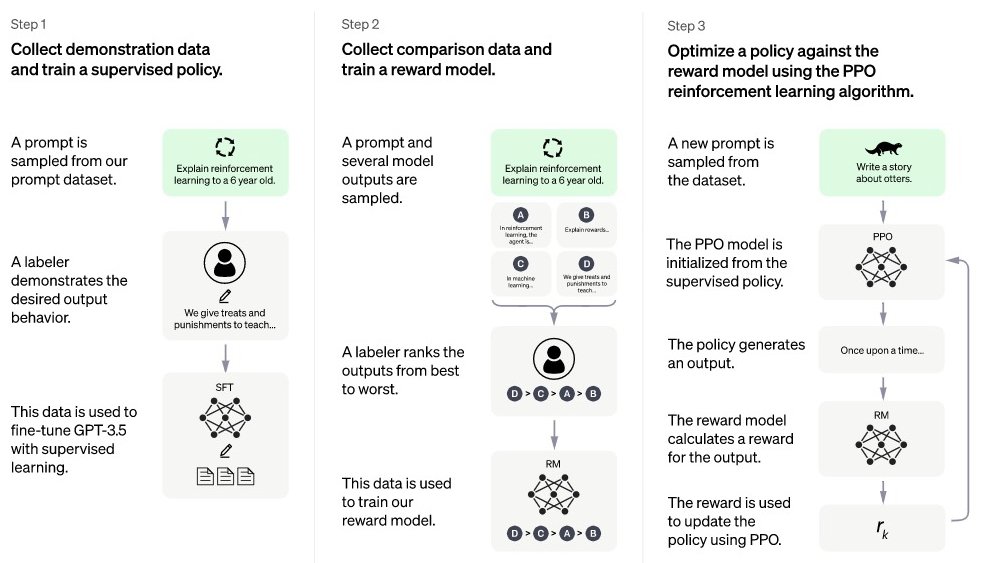
Steps Involved in natural language processing:
1. Sentiment Analysis: With this, the algorithm tries to interpret the sentiment of the user’s query.
2. Tokenization: The NLP divides a string of words into pieces or tokens.
3. Named Entity Recognition: The model looks for categories of words.
4. Normalization: The model processes the text to find spelling mistakes or typographical errors in the user’s intent.
5. Dependency Parsing: The chatbot looks for the objects & subjects to find what users might be trying to convey.
At first, the model is trained using supervised fine-tuning, wherein AI trainers simulate conversations with both a user and an AI assistant. To make these conversations more intelligent, AI trainers are given access to model-written suggestions, which can be integrated into the conversations.
After this, a reward model for reinforcement learning is constructed by collecting comparison data, which consists of two or more model responses ranked by quality. For this data, conversations between AI trainers and the chatbot are randomly selected, alternative completions for these conversations are written by the model, and AI trainers rank them. Using the reward models, refined models are created using the Proximal Policy Optimization technique. This is then followed by several iterations of the same process to ensure maximum intelligence.
In conclusion, by using RLHF with slight alterations to the data collection setup, chatbot makers are able to train their models to become intelligent and capable of carrying out human-like conversations. Here is a list of things that the method uses:
- Supervised fine-tuning
- Model-written suggestions
- Comparison data
- Reward models
- Proximal Policy Optimization
- Iterations of the same process
What sets ChatGPT apart from other chatbot services?
ChatGPT as of 2022, is fine-tuned from GPT 3.5, a powerful new model for AI that has been trained on an Azure AI supercomputing infrastructure. This allows it to provide more accurate and natural language understanding and response capabilities.
How to use ChatGPT for SEO
To stay ahead of the competition, SEO professionals need to have a diverse set of tools and strategies at their disposal. One of the newest tools on the market is ChatGPT, an AI-based language processing system that can respond to user queries automatically. In this ChatGPT SEO guide, we explore some of the key ways that ChatGPT is being utilized for SEO purposes.
1. Blog Ideas for Website: We can generate hundreds of unique blog ideas as per your business.
Prompt: Blog Ideas for “digital marketing agency”
Prompt: content marketing ideas for “digital marketing agency”
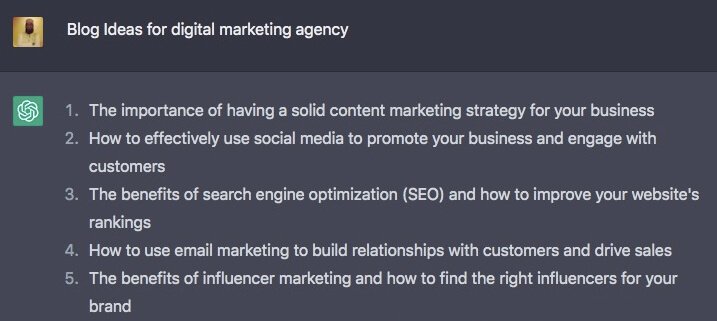
2. Keyword Research and LSI Keywords: We can use ChatGPT to generate relevant keywords for our article.
Prompt: keywords for “content marketing” or LSI keywords for “content marketing”
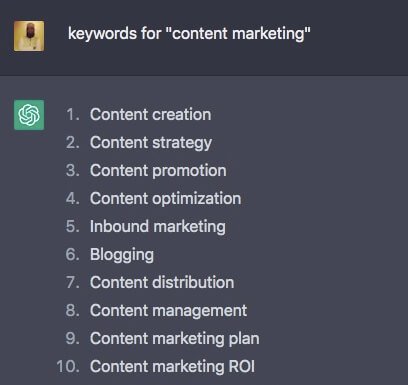
3. Create Content Structure for blogs and pages: We can generate content structure easily with ChatGPT. I used the following prompt by using 1st idea from the above list.
Prompt: Blog structure for “The importance of having a solid content marketing strategy for your business”
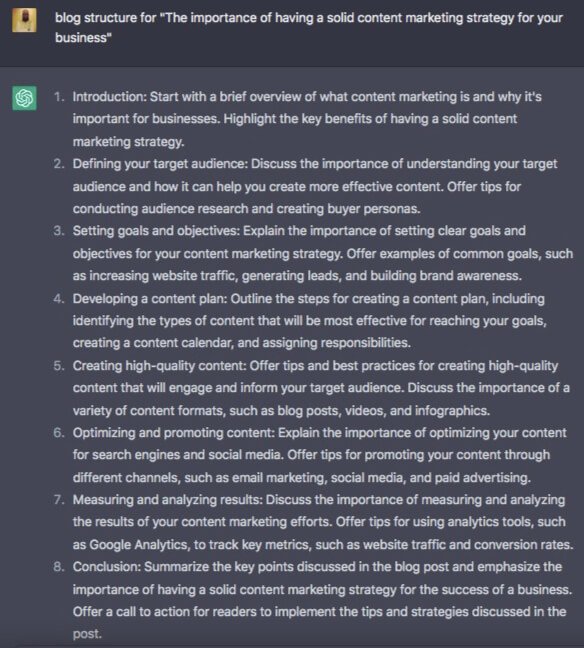
4. Generate Content based on the above structure
Prompt: content for “what content marketing is and why it’s important for businesses”

Using the above method we can generate a complete article using ChatGPT. We have to modify the content and add storytelling factors or certain unique examples to make the content more appealing and avoid any detection.
Prompts for Content Generation:
Write 1000 words of content about “content marketing and its importance for business”
Note: Google has algorithms to detect AI-generated content. So it’s mandatory to modify the content to make it relevant and remove any type of content pattern in the page.
5. Generate Creative SEO Titles: ChatGPT can generate hundreds of high-quality SEO titles which can lead to higher CTR.
Prompt: Creative SEO Titles for “Content Marketing”
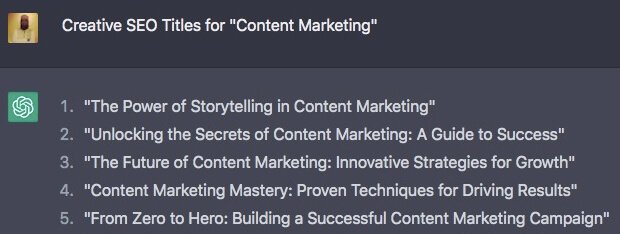
6. Generate Meta Description Tags: Create highly converting meta descriptions with appealing content.
Prompt: Meta descriptions for “Content Marketing” in 160 characters.
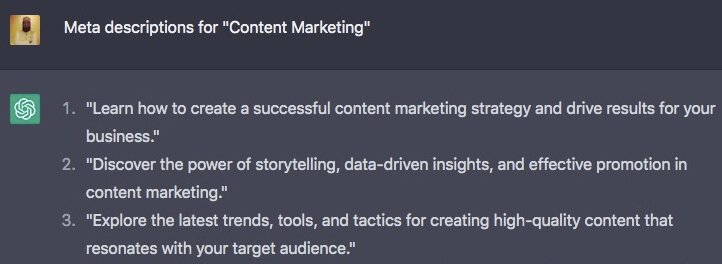
7. Generate FAQ for Website: ChatGPT can be used to generate high-quality FAQS for websites.
Prompt: generate FAQ for “content marketing”
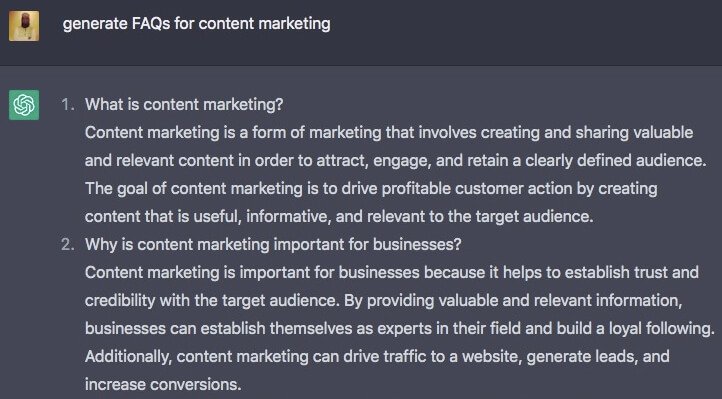
8. Generate Schema Code for integration: ChatGPT can be used to develop various types of schema code easily, like FAQ Schema, Ratings Schema, etc.
Prompt: Generate FAQ Schema for the above FAQ
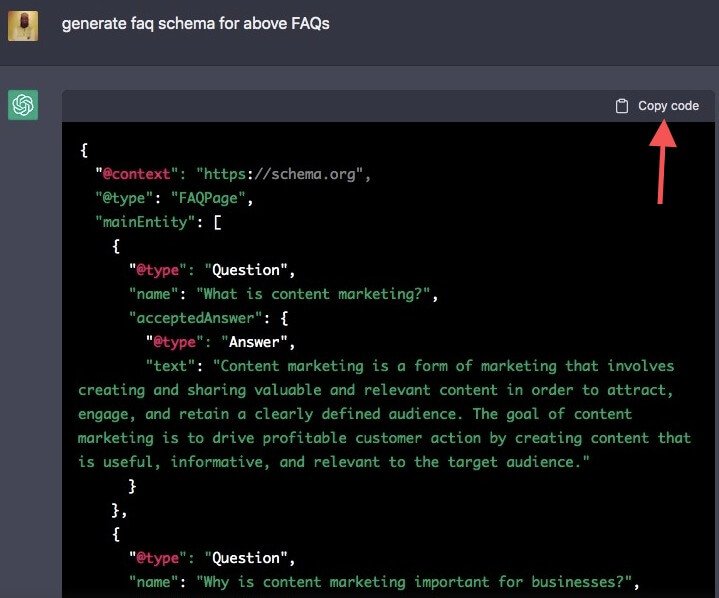
Once the FAQ schema code is generated, we can copy the above code and integrate into our website.
9. Generate Sitemap code: It can generate sitemap code for the website.
Prompt: Sitemap code for website
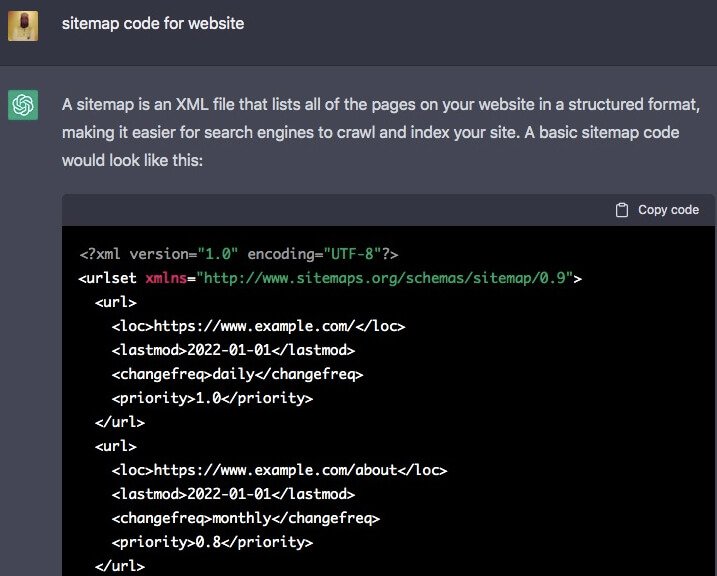
10. Analyze Data: ChatGPT can be used to analyze data from websites and other sources to identify patterns in customer behavior. This data can then be used to improve strategies and develop more effective campaigns.
11. Website Optimization: ChatGPT can also be used to optimize website code, layout, and other elements to improve performance and ranking in search engine results.
12. Website Monitoring: ChatGPT can be used to monitor websites for changes and other issues, helping to ensure the website is always optimized for SEO.
In conclusion, as you can see, ChatGPT can offer a huge range of benefits to SEO professionals, from automation and customer service to data analysis and website optimization. By leveraging the power of ChatGPT, SEO professionals can take their campaigns to the next level and achieve greater success in their SEO journey.
ChatGPT Limitations for SEO
Search engine optimization (SEO) is a key component of online marketing and chatbot development. Chatbot technology, such as ChatGPT, can help boost website visibility, engagement, and conversions. But at the same time, ChatGPT may also create issues that affect SEO negatively.
Dynamic Generic Content issue: The first SEO issue related to ChatGPT is the use of dynamic content. ChatGPT relies on dynamic content to provide responses to user inquiries. This dynamic content may be treated differently by search engine crawlers. This could potentially lead to a decrease in search engine rankings, as well as a drop in user engagement.
If the dynamic content is not indexed properly, a website can suffer in search rankings and visibility. The use of ChatGPT also makes it easier to produce a large volume of content quickly. However, this opens up the risk of search engine algorithms detecting a pattern in the writing and punishing it with a penalty. In fact, Google has algorithms to detect AI-generated content.
Since ChatGPT systems are still relatively new, they have not been thoroughly tested by SEO specialists. This lack of testing could lead to unexpected issues, including poor performance or incorrect optimization.
Data Bias & Lack of Context: ChatGPT is trained on a large dataset of conversational text, but the data may contain bias. This can lead to the model generating text that is biased or offensive.
ChatGPT generates text based on the input it receives, but it may lack context. This can lead to text that is not relevant or is not consistent with the input context.
As search engines give high importance to the Intent & Context of the query. The content generated by ChatGPT may not be sufficient to answer the query of the user.
Duplicate Content issue: Another issue to consider is the potential of duplicate content. The automated portion of your chatbot may provide the same response to multiple user inquiries. This duplicate content can cause problems with search engine crawlers, leading to a potentially lower ranking in search results.
Google Algorithmic Changes: As more and more AI-driven bots are implemented for search engine optimization, search engines like Google will be making more and more changes to their algorithms. SEO practitioners need to stay abreast of these changes and adjust their strategies accordingly.
SEO Strategy issue: One of the most important issues related to ChatGPT is that it is not a suitable replacement for traditional search engine optimization. While it is possible to develop a successful SEO strategy through the use of chatbots, this is usually only the case if it is backed up by a traditional SEO strategy. This is due to the fact that, while chatbots can provide a lot of useful information to users, they are not as versatile, efficient, or useful as keywords, link building, and other SEO tactics.
When deployed correctly, ChatGPT can drive additional organic traffic to a website or application. However, SEO hurdles can arise when appropriate attention is not devoted to the integration of a chatbot.
Optimizing keyword issue: The biggest issue with ChatGPT is that it may not recognize keywords or optimize for search engine optimization. It simply answers the questions from the website visitor and returns an “answer”.
This can create problems for the website’s search engine ranking, as the pages containing ChatGPT’s answers will not appear prominently in search engine results pages (SERPs). In addition, longer, more complex answers are more difficult for the ChatGPT to comprehend and answer. This makes it difficult to effectively use long-tail keyword phrases in the SEO copy since more complex phrases are more difficult for ChatGPT to understand.
Lack of current trending data: ChatGPT articles are solely generated from historical data, which can miss out on current trends or topics. The present version of ChatGPT has data up to Dec 2021. This makes it difficult for such articles to compete on SEO when it comes to must-have topics or news. Additionally, the natural language generated by ChatGPT does not rigorously follow the rules and styles that search engine algorithms are designed to detect.
Lack of Human Emotions and understanding: ChatGPT is based on machine learning and does not have a true understanding of the text it generates. This means it can’t answer questions or generate text based on a true understanding of the context.
Conflict with traditional SEO practices: Finally, another issue that is important to consider when developing a successful SEO strategy through ChatGPT can be the lack of data about user searches and activities that can drive organic traffic to a website.
It’s highly recommended to use ChatGPT as assistance for your project. Relying completely on ChatGPT will be negative for SEO.
How to use ChatGPT in the right way?
As companies and organizations strive to meet customer needs in an ever-advancing world, they often turn to technology to provide customers with an efficient and convenient way to communicate. Therefore, in order to get the most from ChatGPT, it’s essential to have a good understanding of its capabilities and use them in the right way. In this blog section, we’ll discuss the key elements of using ChatGPT in an accurate and effective way.
Best practices for using ChatGPT for ChatBot Development:
Define Clear Goals and Outcomes: Before deploying ChatGPT, it’s important to define what you want the chatbot to achieve. Determine the types of tasks you want the chatbot to help customers with, the outcomes you’d like the customers to achieve when they use the chatbot, and any restrictions you may have in place.
Customize the Conversation Prompts: Customize the conversation prompts to ensure your customers are receiving information tailored to their needs. Provide your team with a list of conversation topics and scenarios beforehand, so you can stay on top of any changes and optimize the customer experience.
Monitor and Test: Monitor and test the chatbot regularly to ensure it is providing accurate and consistent service. Make sure the chatbot is responding to customer requests in an engaging and meaningful way, and that its response time is fast and accurate.
SEO Strategy: As mentioned above use ChatGPT features as assistance for your SEO Work. Using this tool along with regular SEO will be highly effective.
Social Media Marketing: Use ChatGPT to create social media content ideas, and generate ad headlines, descriptions and captions.
Conclusion:
In conclusion, ChatGPT is a powerful tool that can be used to enhance SEO efforts and achieve higher rankings. As a language generation model, it can be used to create high-quality and relevant content, generate meta tags and descriptions, and optimize website copy.
However, it’s important to remember that ChatGPT is not a magic solution and it has its own limitations. It’s crucial to understand the data bias, lack of context, lack of understanding, language limitation, reliance on data, and language generation not always perfect. Additionally, it’s important to use ChatGPT in conjunction with other SEO best practices, such as keyword research, link building, and website optimization. With the right approach and understanding, ChatGPT can be a valuable asset in any SEO strategy.

























